

Pommern 1945 - Teil 1 [Homepage des Familien-Vereins Zessin] Der Kampf um Pommern im März 1945 Heeresgruppe Weichsel Von Willi Weiss, Juni 2011 Zum Vergrößern bitte auf die Fotos klicken.
![Pommern 1945 - Teil 1 [Homepage des Familien-Vereins Zessin]](http://cdn.pearltrees.com/s/pic/th/pommern-homepage-familien-83646134)
Am 2. März 1945 stellt sich die Feindlage an der Ostfront folgendermaßen dar: Gegenüber der 8. Hinweis zum Text :Bei den hier wiedergegebenen Berichten handelt es sich um die Abschrift der original Wehrmachtsberichte aus dieser Zeit. Am 2. Der Russe erweiterte am 3. Küstrin stand am 6. Da sich in Danzig 100.000 Flüchtlinge befinden, ist die gesamte Summe der Flüchtlinge nun auf 10 Millonen angestiegen!
Gegen Graudenz beginnt an diesem Tag ein russischer Großangriff. An diesem Tag, am 8. Im wesentlichen hat sich die Lage am 10. Die Vorstadt von Küstrin, Kietz, ging am 11. Auf der Autobahn Stettin – Altdamm rücken russische Panzer vor, im Norden werden die eigenen Kräfte zurückgedrängt, ebenso in Wollin. Der Russe setzte den Druck gegen die 2. Am 21. Pommern 1945 - Teil 2 ☞ Pommern 1946 - Teil 3 [Homepage des Familien-Vereins Zessin] Expulsions from Stolp. The Process of the Expulsions in Eastern Pomerania Account by Pastor Werner Lindenberg from Stolp, Pomerania, January 1946 Translated by Leslie A.

Riggle in Kansas / USA, February 1999 (Taken from: "The expulsion of the German population from the areas to the east of the Oder-Neisse Line", published by the former German Federal Ministry for Expellees, Refugees and War Victims, Volume I/2, Document Nr. 328. Published by Weltbild Verlag GmbH, Augsburg,1993) While in other parts of eastern Germany the mass exodus began already in early summer, an organized plan was not put into operation in eastern Pomerania until October 1945. 1. that he was leaving Stolp of his own free will. 2. that he had no claim against the Polish state. 3. that he would never return to Stolp. 1,000,000 Women and Children Kidnapped. This story is only about a fraction of German civilians taken to the death camps by the Soviets.
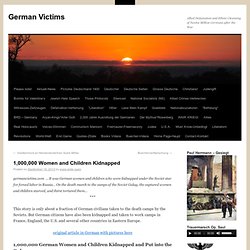
But German citizens have also been kidnapped and taken to work camps in France, England, the U.S. and several other countries in Eastern Europe. original article in German with pictures here 1,000,000 German Women and Children Kidnapped and Put into the Gulags FOCUS, NR. 38/2001 – Sept. 15, 2001. The Wehrmacht War Crimes Bureau, 1939-1945. The Wehrmacht War Crimes Bureau, 1939-1945 is a book by Alfred-Maurice de Zayas.
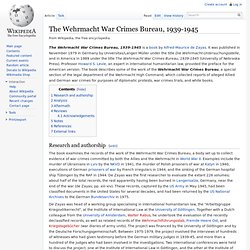
It was published in November 1979 in Germany by Universitas/Langen Müller under the title Die Wehrmacht-Untersuchungsstelle, and in America in 1989 under the title The Wehrmacht War Crimes Bureau, 1939-1945 (University of Nebraska Press). Professor Howard S. Levie, an expert in international humanitarian law, provided the preface for the American version. The book describes some of the work of the Wehrmacht War Crimes Bureau, a special section of the legal department of the Wehrmacht High Command, which collected reports of alleged Allied and German war crimes for purposes of diplomatic protests, war crimes trials, and white books.
Research and authorship[edit] “A Day in the Life Of…”: Women of the Soviet Gulag « The View East. Flight and evacuation of German civilians during the end of World War II. Plans to evacuate German population from the occupied territories in Central and Eastern Europe and from Eastern Germany were prepared by German authorities at the end of World War II.
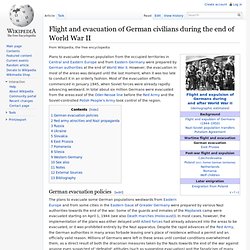
However, the evacuation in most of the areas was delayed until the last moment, when it was too late to conduct it in an orderly fashion. Most of the evacuation efforts commenced in January 1945, when Soviet forces were already rapidly advancing westward. In total about six million Germans were evacuated from the areas east of the Oder-Neisse line before the Red Army and the Soviet-controlled Polish People's Army took control of the region.
German evacuation policies[edit] Red army atrocities and Nazi propaganda[edit] German street posters in Danzig as the Red Army approaches, warning soldiers that escaping with civilians will be treated as desertion. Russia[edit] Flight and expulsion of Germans (1944–50) Red Army troops raped even Russian women as they freed them from camps. He appears to echo the American feminist Marilyn French's notorious claim that "in their relations with women, all men are rapists, and that's all they are".
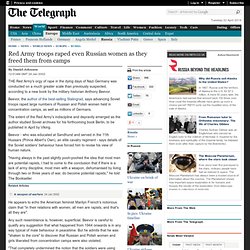
Any such resemblance is, however, superficial. Beevor is careful to qualify any suggestion that what happened from 1944 onwards is in any way typical of male behaviour in peacetime. But he admits that he was "shaken to the core" to discover that Russian and Polish women and girls liberated from concentration camps were also violated. "That completely undermined the notion that the soldiers were using rape as a form of revenge against the Germans," he said. "By the time the Russians reached Berlin, soldiers were regarding women almost as carnal booty; they felt because they were liberating Europe they could behave as they pleased.
Beevor's high reputation as a historian ensures that his claims will be taken seriously. No Escape For Gulag's Former Prisoners. Untitled. The German Nazi crimes against the Polish nation, claimed approximately 5.6 million, to 5.8 million lives,[5] of whom 3.1 million were Polish Jews, two million were ethnic Poles, and the remaining half-a-million minorities.[6] The crimes were committed during the course of the 1939 invasion, as well as the subsequent occupation of Poland in World War II.
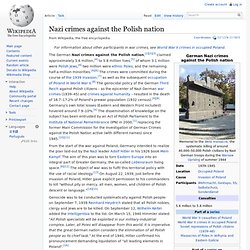
The genocidal policy of the German Third Reich against Polish citizens – as the epicenter of Nazi German war crimes (1939–45) and crimes against humanity – resulted in the death of 16.7–17.2% of Poland's prewar population (1932 census). Germany's own total losses (Eastern and Western Front included) hovered around 7.9–10%. Nemesis at Potsdam. The book is the first scholarly study in the English concerning the expulsion of Germans after World War II.[1] It effectively broke a taboo in the English-speaking world, and also in Germany and Austria, thus facilitating subsequent research in the subject by other scholars.
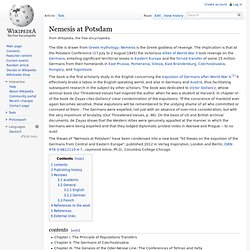
The book was dedicated to Victor Gollancz, whose seminal book Our Threatened Values had inspired the author when he was a student at Harvard. In chapter VI of the book de Zayas cites Gollancz' clear condemnation of the expulsions: "If the conscience of mankind ever again becomes sensitive, these expulsions will be remembered to the undying shame of all who committed or connived at them…The Germans were expelled, not just with an absence of over-nice consideration, but with the very maximum of brutality. (Our Threatened Values, p. 96). Contents[edit] Chapter I. Publishing history[edit] The book was first published by Routledge & K. 'I Did Nothing Wrong': German Gulag Prisoners Recall Their Postwar Ordeal. Father!

When Karl Heinz Vogeley climbs down from the train at 3:30 a.m. clutching his old wooden suitcase, his relatives are there to greet him. He runs toward the man who stands waiting on the platform at the Haldensleben train station -- and only then notices that it isn't his father, but his uncle. His father is standing off to one side, he has grown old.
The Gulag: Communism's Penal Colonies Revisited. The Gulag: Communism's Penal Colonies Revisited Dan Michaels During the twentieth century it became common practice for nations to detain citizens whose loyalty to the state was considered unreliable or suspect in times of war or "national emergency.
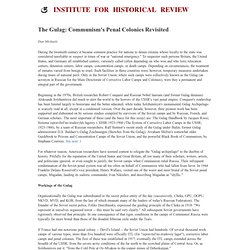
" To sequester such persons Britain, the United States, and Germany all established centers, variously called (often depending on who won and who lost) relocation centers, detention centers, labor camps, concentration camps, or death camps. Women of the Gulag. I often thought that all contemporary witnesses I met during my trip should have their story recorded, in their own words and their own voice, and that these stories should be available in some kind of database (akin to the Shoah Foundation); both for scholars and as a memorial to what happened to men and women in camps, in war and peace and after their return.
I was delighted to find out that Russian filmmaker Marianna Yarovskaya and American academic Dr. Paul Gregory are doing exactly this: conducting as many interviews as possible with women who survived the Gulag camps, before the voices of these witnesses vanish forever. The two are currently seeking founding over on Indiegogo, and you should definitively contribute to this amazing project, with funding going towards both a feature documentary about the women and an upcoming book by Paul Gregory. Did I mention that you should pledge over on Indiegogo? Do it now! Marianna kindly answered a few questions regarding the project.